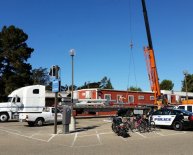
Machineries for Construction
Helena Berg talks about energy storage systems for construction machineries in conjunction with her lead role in a Construction Climate Challenge research initiative.
Over the last 10 years an unprecedented surge has taken place in the manufacture of battery powered vehicles. The automotive industry has rose to the ever-increasing demand for cleaner, environmentally conscious transport solutions.
In a CCC research initiative, Helena Berg is leading a project at Chalmers University of Technology. In the project, they strove to find a way “through the forest” of current energy storage systems. Focused primarily on the crucial details along the full chain, from materials via cells, to packs and to installation and charging, Helena and her team aimed to review if the current research and development in this field is fit to meet the construction site climate challenges.
“We decided to set up a project to look into which route we should take. Our aim was to help find which battery technology is needed from a sustainable, cost and performance perspective, ” she explains.
Helena welcomes the advancements that companies like Tesla are making in the automotive industry, but is acutely aware that construction machinery still has a long way to go in terms of battery dependency.
“In the construction site you need to optimize the battery. Tesla has shone a light onto the battery industry, which is good. Now it’s not that strange to think about a fully functioning electric construction site anymore, ” she explains.
What became apparent in the study is that battery performance is only half of the challenge. To select the right battery it is crucial that sustainability calculations run parallel to economical costs. Finding energy storage solutions that are both economically and sustainably viable is the greatest challenge.
Conclusively, batteries like the Na-ion and asymmetric super capacitors were earmarked as battery lead-runners, due to their high rate capabilities, pack simplicity and low environmental impact.
However, according to the research, regardless of the emerging technology chosen, the charging strategies will always highly affect the lifetime cost, pack installation, and environmental impact of the energy storage. Charging on a construction site many times during the day, from a weight and volume perspective, was seen as preferential in terms of saving costs. But from a lifetime and environmental perspective, charging was recommended only a few times during the day, lunch breaks or during the night.
R: What is the biggest challenge for batteries in heavy machines?
H: Construction machines are unique to other hybrid and electric vehicles because they require more energy in less time. The power demands are challenging if you compare to a bus or a passenger car. You can’t use the same cells because you need something that can deliver power in a short time.
R: Is the development of a sustainable and powerful enough battery for construction vehicles currently too far behind to make a considerable change in the foreseeable future?
H: I think it’s about taking what’s best now and doing something with that. Learn how to make the vehicle and then change the battery. There’s research going on now for example at Chalmers, where they are combining a super capacitor and a battery in one cell. From that perspective I would like to see more research in that field.
R: Can batteries be given a second life, and applied in, for example, hybrid systems to lower the cost of storage?
H: In general, yes, depending on where you are. It’s naïve to say exactly how long batteries can last. It’s almost impossible to know right now. It’s tricky how to arrange the batteries, the warranties, if you lease out the batteries, and how to really guarantee what is left in the battery.
R: What would you say the most important findings were in your study?
H: That you can’t just look for performance; you must have the sustainability calculations in parallel when you select your technology. Otherwise you can put so much money into the wrong direction. It’s so easy to forget the importance of sustainability in research and you can find yourself in a dead end.

















